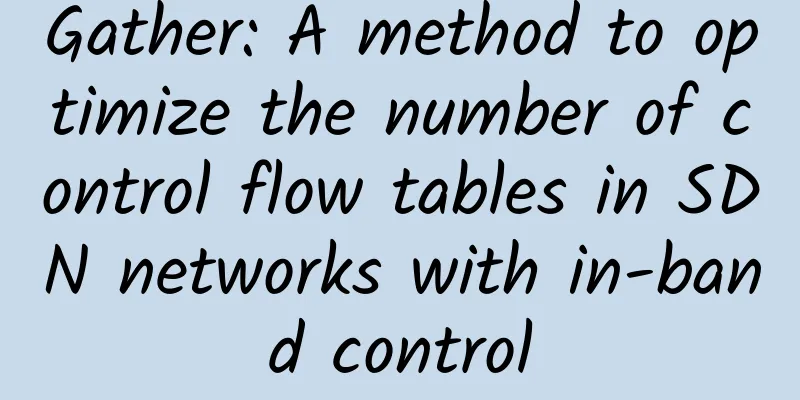Gather: A method to optimize the number of control flow tables in SDN networks with in-band control

|
1. Introduction In-band SDN networks have attracted more and more attention due to their good flexibility and economical deployment. However, in in-band SDN networks, control flows and data flows share a physical link for forwarding. Therefore, switches need to store flow entries for forwarding control flows. This will cause too many flow entries in some SDN switches close to the controller in some large networks, such as data center networks. A large number of flow tables will not only make management complicated, but also occupy network resources such as TCAM. So we proposed Gather: a method to optimize these flow entries for forwarding control flows. 2. Design Introduction (1) Design basis The following figure shows the flow table distribution diagram of the SDN network under traditional in-band control (this article only focuses on the case of one controller): Figure 1: Organization of flow tables in traditional SDN networks In a network topology, if the shortest path algorithm is used to calculate the path from each switch to the controller, a tree-like control topology can be obtained. Gather is optimized based on this tree-like topology. From the figure, it can be seen that the characteristic of flow table storage in traditional networks is that switches close to the controller need to store flow table items of control flows for subsequent child nodes. Therefore, switches closer to the root (controller) need to store more flow table items of control flows. In networks with a large number of switches, such as data center networks, this will cause a significant surge in the number of flow tables in switches close to the controller. The main goal of Gather is to reduce these unnecessary flow table overheads. (2) Design ideas The basic idea of Gather is to divide the switches in the topology into groups. A group is equivalent to a connected subset of the entire control tree. At the same time, a group is represented by a label (label or tag). There are many ways to implement labels. In this article, we use segment routing to implement the label system. The following figure is a schematic diagram of Gather: Figure 2: Gather flow table optimization diagram As can be seen from the figure, S2, S3, and S4 are grouped together, and all packets sent to this group are labeled with an X label. After receiving the packet, S2 will know that the packet is data sent to the switch in the group by matching the X label. It will then continue to match the flow table of the packet in flow table 2 to determine the forwarding strategy. At the same time, after a round of topology optimization, a second round of optimization can still be performed based on the existing grouping. The specific approach is to treat all groups as switches and replace them. After that, a reduced topology will be obtained, and the optimization can be repeated on this topology to further reduce the flow table of the control flow. But at the same time, one label will be added to the data packet. (3) How to find a valid group? There are many ways to find effective groups, and you can design the required algorithms according to your needs. Before introducing the algorithm, some definitions are given first: Node distance refers to the number of intermediate nodes from a node to the controller, S refers to the set of child nodes, G is the set of groups output in the end, and time of optimization refers to the number of times the full topology is optimized. After one optimization, the topology needs to be modified (groups and switches are replaced). In this algorithm, the basic idea is to use the depth-first algorithm first and start calculating from the leaf nodes. As can be seen from the algorithm, it uses an iterative idea, extending to a leaf node and then calculating and comparing each node upward. Then it will determine the distribution of the group based on the comparison results. 3. Design Test First, we test the effect of the label in the data packet (the structure of the group is implemented using segment routing in this paper) on the forwarding delay. The test results are as follows: Figure 3 Test results of the number of labels on forwarding delay From the table, we can see that labels have little impact on forwarding delay. Even in the case of 3 labels, the delay is only 4% higher than that of traditional forwarding. We then tested the ability to optimize the flow table, and the results are as follows: Figure 4 Schematic diagram of flow table optimization structure It can be seen from the three topologies that the results of the first optimization are generally good, while the results of the second and third optimizations drop very quickly. This is because the topology after replacing the group with the switch in the first optimization is much smaller than the topology before optimization. Therefore, the number of flow table entries that can be optimized is also much smaller. At the same time, this is also related to the design of the algorithm. |
<<: Robotics and AI: The future of software testing and development
>>: Prefabricated Data Centers – Winning Edge Data Centers
Recommend
When will the API chaos end? Ruishu Information strikes hard to eliminate the "chronic disease"
In the era of "everything can be API", ...
Can 5G RedCap technology help operators regain confidence?
As my country has built the world's largest 5...
IntoVPS: Hourly KVM monthly fee starts at $5 ($0.0075/hour), 6 data centers available
IntoVPS is an unmanaged VPS hosting brand launche...
Combining AI and big data, the intelligent operation and maintenance platform helps Liulishuo improve its core competitiveness
High-quality content and customized services enha...
IPv6 is coming, what should we do with SDN?
IPv6 has been called for so many years, and final...
What are the differences between VLAN and VXLAN? What are the application scenarios of VXLAN?
With the development of network technology, cloud...
Four Best Practices for Network Cable Management
If a cabling project is to be successful, you fir...
5G spreads the new coronavirus? Foreigners took it for granted and many 5G base stations were burned down
According to foreign media reports, recent conspi...
Wi-Fi 6 is here: These 12 questions will clarify it for you
5G is here, and WiFi 6 is here too. Everyone has ...
With the handshake of 5G, intelligent transportation will usher in four major qualitative changes!
At present, for any ToB market, 5G+AI is creating...
Sharktech Spring Promotion, 10Gbps unlimited traffic high-defense server starting from $299/month, 2*E5-2678v3/128G/2TB NVMe/4 computer rooms including Los Angeles
Sharktech has launched a spring promotion, with d...
DataView standardizes indicator management to help enterprises quickly formulate SLOs
In the wave of digital transformation of enterpri...
Let's take a look at what new tricks Huawei has come up with during its ICT Ecosystem Tour in China!
[51CTO.com original article] At the Huawei China ...
Aruba and China Telecom Global form strategic partnership to help Chinese companies expand overseas
Aruba, a subsidiary of Hewlett Packard Enterprise...









